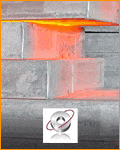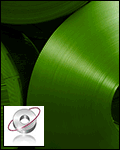Steel Industry Glossary of Terms: T-Z
Technical glossary - common acronyms
| Term | Glossary Explanation |
| Teeming | The pouring of molten metal from a ladle into an ingot mould. The economic advantages of continuous casting over ingot casting mean that the ingot-route process has largely been superseded for high volume production of steel |
| Tensile strength | The maximum load applied in a tensile test divided by the original cross-sectional area of the test piece. Also known as Ultimate Tensile Strength or Maximum Stress |
| Terne coated | Cold rolled steel that has been hot dip coated with a lead coating (usually >90% lead). The most common application of terne coated steel is car petrol tanks |
| Thin slab casting | Production of a slab approx 50 mm - 75 mm thick in a process that is integrated with hot strip casting. The thin slab casting process requires much less gauge reduction of the slab (otherwise undertaken in roughing mills starting with perhaps 250mm thick slab) and the integration with strip rolling means much reduced reheat needs (saving time and energy cost) |
| Tin foil | Thin gauge material (typically 0.016mm thick) nowadays generally made from aluminium, commonly used for food wrapping. Aluminium is preferred to tin as it is generally more pliable |
| TMT | Thermomechanical treatment |
| Toll rolling | Also referred to as hire rolling this glossary term refers to the practice of rolling steel as a service - typically by a firm that does not have ownership of the steel |
| Tonne | Unit of weight commonly used outside the USA, which refers to a metric tonne. A tonne is 1000 kilograms or ~2204.6 pounds |
| Tool steel | Carbon and alloy steels that have high resistance to abrasion. As the name suggests this product group is especially well suited to the manufacture of tools (including stamping dies, shear blades, and hand tools such as spanners, machine tool bit holders etc) |
| TOR | TOR steel bar is another term for twisted deformed reinforcing steel bar (as distinct from TMT treated steel bar) |
| tpt | Tonnes per tonne - refers to process charge as the inverse of yield loss. Thus a charge of 1.05 tpt is the starting weight for a manufacturing step with ~95% through yield |
| Tundish | A reservoir for holding liquid steel and feeding the steel in a controlled manner into a continuous casting machine |
| Turnings | Metal shavings formed during the course of metalworking. Also know as swarf |
| ULCOS | Ultra Low CO2 Steelmaking |
| ULCOWIN | Ultra Low CO2 electrowinning steelmaking process. This is a low-temperature electrolysis process that produces solid state elemental iron from iron ore |
| ULSAB | Ultra Light Steel Auto Body - a joint initiative undertaken by vehicle designers and steelmakers to create a lighter stronger autobody, improve vehicle fuel efficiency and improve emission performance |
| UTS | Ultimate Tensile Strength. See Tensile Strength |
| Vacuum degassing | A secondary steelmaking operation in which the molten steel is exposed to a vacuum. It results in the removal of gases, particularly hydrogen and usually enables improved cleanness levels to be obtained |
| VAR | Vacuum Arc Remelting. A method of producing ingots with lower gas content, fewer inclusions and reduced segregation. The process consists of melting a cast or wrought electrode with a DC arc under high vacuum. Molten droplets exposed to the vacuum are collected and solidify to ingot in a water-cooled copper mould |
| VOC | Volatile organic compounds. May be released to the air as an emission during electric steelmaking - thus a potential health risk if not monitored or controlled |
| VOD | Vacuum Oxygen Decarburisation. A ladle steelmaking process in which oxygen is injected into molten steel under vacuum. This allows carbon to be removed from the steel without oxidising chromium. A method of refining stainless steel (see also AOD) |
| White goods | Reference to refrigerators, freezers, ovens, washing machines, tumble driers [often painted white] which make up a distinct steel-consuming segment (especially significant in flat products) |
| Wire drawing | The reduction in cross-section of descaled rod by progressively pulling it through dies. The resulting product has a bright surface, improved mechanical properties and closer dimensional tolerances. Distinguished from bright drawing by being a coil-to-coil process |
| Wrought iron | Iron that has a low carbon content (usually les than 0.15 per cent). Many traditional applications of wrought iron now use low carbon steel instead |
| WSA | World Steel Association. One of the leading world steel industry associations. Formerly IISI |
| Yellow goods | Reference to fork lift trucks, bulldozers, earth-moving equipment etc [typically painted yellow] which represent a distinct steel-consuming segment |
| Yield | Measure of efficiency of a steelmaking process stage, often expressed as a percentage. Typically calculated as the weight of steel produced in a given manufacturing step relative to the quantity charged |
| Yield strength | The stress at which permanent deformation occurs in a tensile test. In many steels, this point is not readily distinguishable and a proof strength value is used as an alternative (see also Proof Strength) |
Quick Navigation
WEBSITE HUBS
Steel News Hub
Price Hub
Knowledge Base
History Hub
Advice Hub
Supplier Hub
Technology Hub
M&A Data Hub
Trump Tariffs NEW
WEBSITE HUBS
Steel News Hub
Price Hub
Knowledge Base
History Hub
Advice Hub
Supplier Hub
Technology Hub
M&A Data Hub
Trump Tariffs NEW
© 2001 -
2025 Steelonthenet.com. All rights reserved.
To contact us about this steel glossary of terms please email info@steelonthenet.com.
To contact us about this steel glossary of terms please email info@steelonthenet.com.










